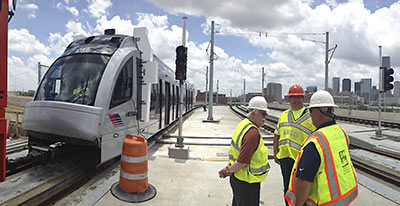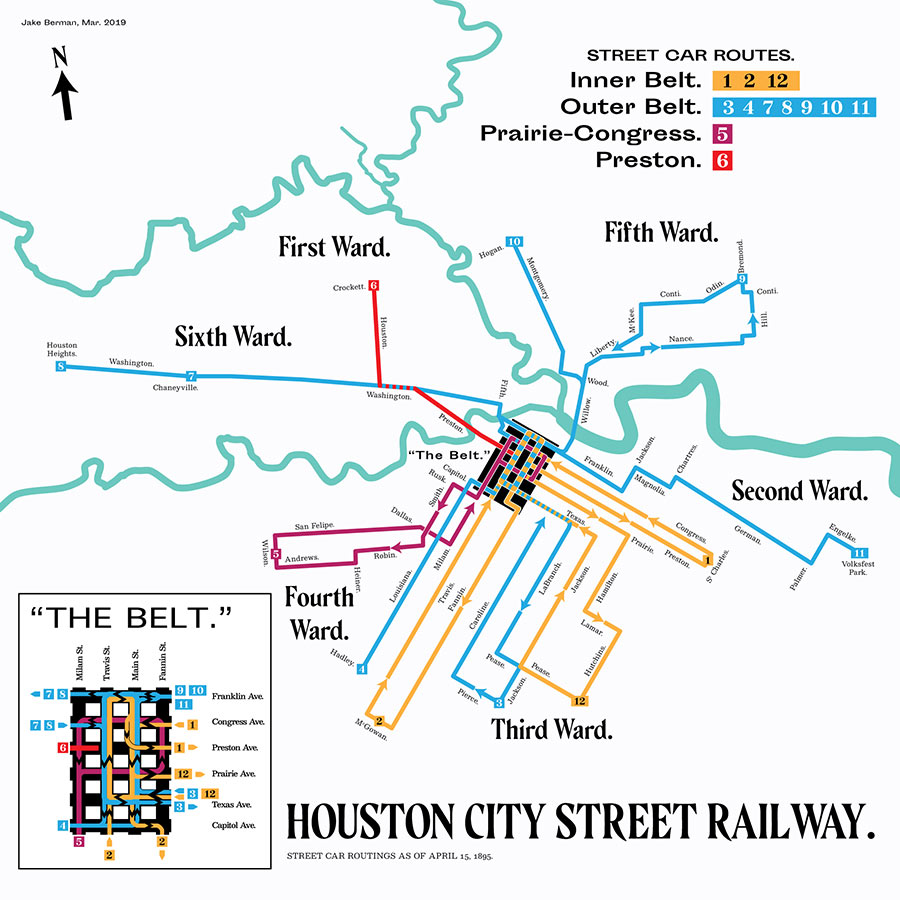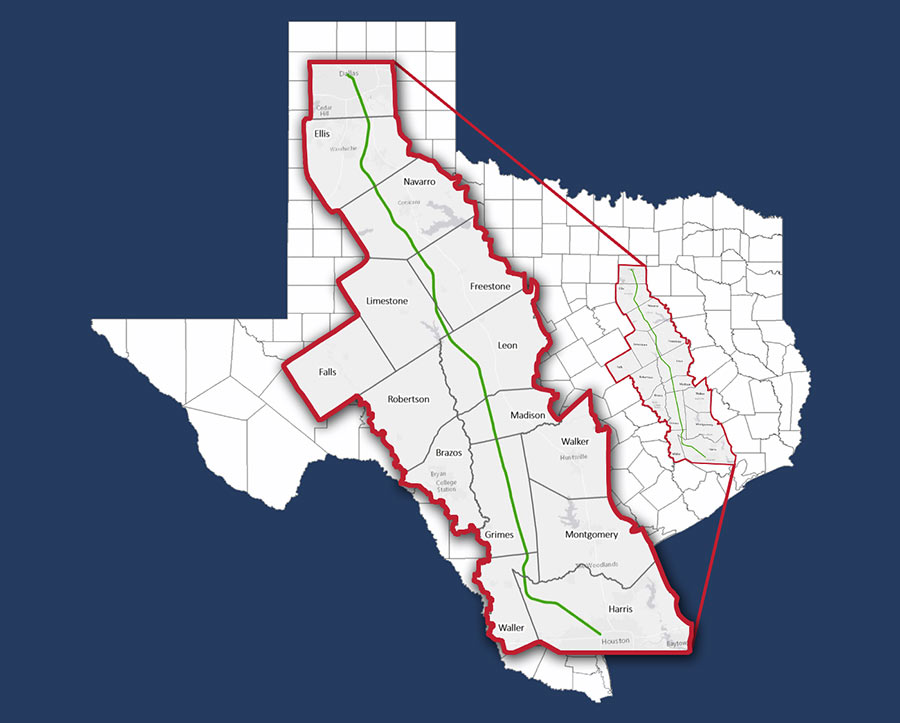
The very first train graced the tracks of the North Line light rail extension earlier today — though this was only a test, says Metro’s Christof Spieler. That explains why you can’t see in this photo taken near the Burnett Transit Center north of Downtown any overhead wires — the train was being towed by a diesel tractor. (Diesel tractor not pictured.) And it explains why you can see that foam bumper: That, says Spieler, was meant to catch anything built too close to the tracks. More test train should be running all by themselves this fall, he adds, and full service is scheduled to go in December.
- Previously on Swamplot: What’s Left of the Burnett Transit Center, Main St. Intermodal Transit Center Kiss-Off, On the Shelf: That Grand North Main Intermodal Center
Photo: Christof Spieler via Swamplot inbox





They should have auctioned off the rights to tow the train and use the footage in an add. Picture it; a Ford F150 towing a train! Toyota got quite a bit of milage out of having their Tundra tow the Space Shuttle over a bridge (the shuttle’s normal tow vehicle was too heavy for the bridge).
This is great for Houston, I only wish it had been built thru The Heights. The trains look great, it’s a shame the Westside fought so hard and pretty much ruined the Westside line, it should have gone down Richmond thru Afton Oaks and terminated at like Sage. It’s so ridiculous that a neighborhood of little consequence (Afton Oaks is hardly River Oaks, Southhampton, Montrose or The Heights) was able to completely derail the logical line, instead it will be difficult to connect to any future Uptown line and in the meantime we get buses?! down the middle of Post Oak…oh goody
@ shannon
I agree 99% of your sentiment. I will, however, take BRT over nothing. The University line was the most important piece of the LRT expansion and it got held up by Culberson and his cronies.
What is lacking going forward is some sort of schedule or threshold that is to be met b/f BRT is converted into rail.
METRO needs to revisit its 2003 ‘Solutions’ model in the face of the new (from last year’s vote) transportation tax reality. We, the voters, are owed a vision of rail, BRT, commuter, and regular buses.
I know METRO is currently looking at adapting / eliminating / creating routes that make sense and are easier to understand. This is a great first step but I think it fails in identifying / establishing a true transportation hierarchy: International/national, regional, job centers / living centers, local. What is rail to serve? What is BRT to serve? Is it to fill the gaps of rail? We have HOV lanes to downtown but what about to Uptown? Should a goal of METRO’s be to make sure that all of Houston’s job centers be connected by HOV? These are questions that I don’t see / hear people asking. We’ve become a region that is content to complain about traffic, the fact that you can’t take METRO to get anywhere, but not offer any true solutions.
@shannon, so are you a suburb commuter? as a resident of the Montrose area I don’t understand your shortsighted, selfish comment that a “neighborhood of little consequence (Afton Oaks is hardly River Oaks, Southhampton, Montrose or The Heights)” is fair game for your convenience. Where people live is of consequence and exercising imminent domain and flooding surrounding neighborhoods with traffic trying to get around the train is something that needs to be considered realistically.The proposed plan for the Richmond rail line effectively closed numerous side streets that residents need access to to get to their homes(without going several blocks out of the way looking for an opportunity to turn left). If you ever tried to use Main St downtown you will begin to understand that simply throwing in a rail line for the convenience of commuters to avoid using their cars in traffic only creates more traffic for people who currently live in the neighborhoods you feel are of “no consequence”
Very excited to see this on my way home yesterday. So many comments over the years here and elsewhere bellyaching about this line running through “the ghetto” and not where it is really needed. It was needed, and this project has already cleaned up Northside Village in so many positive ways, the neighborhood supports it, businesses are being built around it, and the trains will be full in both directions once it opens. I really cannot see one negative impact from this project, it is awesome and that is all.
Since the Richmond rail line is off the table it seems, I think METRO should consider taking rail out Washington Ave. to connect up with the Northwest Transit Center at Post Oak and Old Katy Road. That way it would connect into the Post Oak BRT. Another alternative would be to run rail up N. Houston Avenue and then run west down Pecore/11th to the transit center.
I agree with DNAguy that Metro seems not to have a good integrated plan to cover the next 10-15 years.
Shannon, obviously Afton Oaks is of more consequence than you give it credit for, after all , they fought back and won!
I live off of Richmond in the area and am glad that accident magnet will be crossing over 59 before it gets near me!
@DNAguy,
I think the chances of turning the BRT lanes to rail in the future are slim to none. The amount of steel reinforcement they put in the concrete to support the tracks was unbelievable, and took the longest amount of time, along with the road paving. I just cannot see them putting the BRT in place and then shutting it down for 2-years to support rail.
So, the question is, did they put the rail in the ghetto because only ghetto needs it or because the ghetto was not powerful enough to fight it like every other civilized neighborhood?
N. Houston and Pecore are 2 lane roads… (and Pecore is the emergency access to 45) don’t see that one ever happening.
@SC I don’t think you live on main street, or even within a mile of it.
Numerous people I know do, Afton Oaks would be inconvenienced for a few years while it was being built, but after that it would be no more of an inconvenience than all the retail that has been built on Westheimer between the railroad track and Weslayan.
The people of Afton Oaks deserve every bit of traffic that continues to encroach on their neighborhood. Culberson deserves to have reign over an area that is not serviced by multiple modes of transit, and he should be made to answer for that when (if) it becomes a problem.
Meanwhile, I’ll continue riding the rail, or driving around midtown, downtown and the museums every day without being inconvenienced by the main street rail line because I live in the area and know my way around neighborhoods I spend a lot of time in/around.
I didn’t realize I was living in the ghetto. Thanks for the heads up, commonsense.
@commonsense – usual troll bologna.
More foot and bicycle traffic in my neighborhood than anywhere in the Heights, Fulton bus line is full both directions daily, sprucing up was certainly needed along Fulton, as well as development that is and has already been built around the rail corridor, and I would expect more on the way once its operational. Point is, the Northside supports the infrastructure improvements, the $3million improvements to Moody Park, sidewalks, new lighting, roadway, etc. With only a few early detractors concerned about safety and loss of business during construction, I don’t think you would find many residents opposed to something that is significantly improving neighborhood regardless of not being able to make a left or right turn at every block, so why fight it?
The “Rail in the Ghetto” lines are all in areas that have already have a certain seed capital of gentrifiers and are also safe zones politically. The lower income residents will sustain ridership initially but the expected development enhanced by the rail’s presence will be able to sustain ridership and a much higher tax base for the next 100 years while the lower income people move away where they can seed new areas for future “Rail in the Ghetto” lines.
The unpictured diesel tractor is pictured here:
https://www.facebook.com/media/set/?set=a.10151609059024909.1073741833.167495124908&type=1
Hmmmmm, I knew my assessment of Afton Oaks would be met with some vitriol, however I’m still livid that this little neighborhood of very mediocre style was able to derail an entire line–the most important of the lines frankly all because it would bring “undesirables” thru and might be noisy ( uh, you live down from a freight train track) oh and the oaks!–those oaks could have been dug up and moved, they’re hardly Oak Alley Plantation size. It’s absurd that a few people could derail the greater good–I’m mean who wanted 10 and 59 in their backyard, but they had to be built. Now a Westside line will be last and maybe never built all because of less than 500 people —
Rail down 11th would be a total disaster. there’s nowhere near enough room, and it would make getting in and out of my neighborhood impossible. Just like on the North side, where the rail has made getting from 45 to Hardy nearly impossible.
There is absolutely no reason the proposed University line could not jog under 59 near the train tracks and service the office park, host of apartmentsnear Newcastle on the Westpark right of way that Metro originally proposed many years ago. There is plenty of room for the line to go under 610 and jog up Post Oak extension so all you rail groupies can go the mall.
God forbid that Metro could actually do something to save some costs by using right of way they already have rather than tear up roads and disrupt a neighborhood. Is it so damned important that someone on that proposed train be able to stop at Luling for barbeque? And who cares if Shannon thinks the neighborhood is mediocre–at least they won a battle important to them in the preservation of their area. This system as it is planned is a joke–all it does is replace intown bus service. It does nothing to alleviate traffic.
When people object to running light rail down 11th Street, they think of traffic disruption. The problem is how METRO reserves exclusive lanes for their trains. This isn’t done in most other light rail situations. And. amazingly, cars and light rail can co-exist on the same traffic lane. See this picture of how San Francisco MUNI runs the N-Judah line right down the middle of a 2 lane street
http://www.sfexaminer.com/files/blog_images/Bigshtdown3.jpg
.
Or this example from Philadelphia:
http://studio34yoga.com/art/trolley/nearS34.jpg
.
I do think that Washington Avenue would be a more direct downtown to NW Transit Center corridor, and would help in the long term the commercial establishments in the area. given the amount of apartment construction along Washington Avenue, light rail would allow landlords to charge a premium for rent.
JT,
The proposed route for the University Line already would cross to the south side of 59 before Weslayan and use the existing ROW. To my knowledge there is no plan to have it go by Luling City Market.
http://www.gometrorail.org/clients/2491/372235.pdf
There are no plans to have it go through Afton Oaks, despite what some here have said.